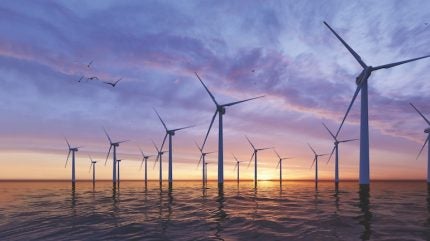
The University of Manchester has been awarded funding to lead a 12-month research project to improve understanding of the energy yield from offshore wind in UK waters, in particular dealing with wake problems as capacity increases.
The new project, POUNDS (Prediction Of UnqualifieD losseS from offshore wind farm wakes), aims to provide a national-scale assessment of interactions between wind farms, supporting policymakers and industry leaders to optimise offshore wind energy production in the drive to net zero.
The UK government has set a target to reach 43-50 GW of offshore wind by 2030. Rapid progress has already been made with 16 GW now in operation and further projects are undergoing development under the recent Contract for Difference Allocations. Nevertheless, achieving the 2030 target requires an up to three-fold increase of capacity, potentially reaching over 100 GW installed capacity by 2050.
Such substantial expansion of offshore wind farms means they must be built closer together, creating ‘wakes’ where wind slows down behind them, making it crucial to understanding how this affects predictions of annual energy production. Wakes have been observed extending 65km and are increasingly impacting the performance of neighbouring farms, reducing the efficiency of the turbines causing conflicts between wind farm operators.
Project Lead Dr Pablo Ouro, research fellow in the department of Civil Engineering and Management at The University of Manchester, said: “Achieving the target of 43-50 GW of deployed offshore wind farms by 2030 is crucial for NetZero and energy security, but reduction in energy prediction due to wind farm wakes must be addressed.”
“Our POUNDS project is key to overcoming these challenges, informing policy makers and project developers about strategies to better quantify these losses. Similar initiatives of national importance have been developed in Germany, The Netherlands and the USA, and our project aims to support the whole UK offshore wind industry.”
The project’s key aims include:
- Assessing how offshore wind farms affect each other’s energy production, and the revenue implications of these impacts;
- Helping to identify the best locations for future offshore wind farms to minimise these losses and ensure the UK’s renewable energy targets are met;
- Validating modelled performance data against operational data;
- Improving model accuracy in forecasting wind farm energy production.
POUNDS will use state-of-the-art mesoscale models – a type of advanced numerical weather forecasting – to model the performance of wind farms spanning UK waters at a resolution of 1 km. It will assess both the wind farms operational in 2023, and the thousands more wind turbines that are planned for 2030.
The analysis will evaluate accuracy of the model relative to real-world data and quantify the effects of inter-farm wakes on predicted energy yield. It will also capture wind-farm wakes and wind-farm performance in comparison to energy export grid data.
By modelling the interactions between wind farms more precisely, the team hopes to provide better guidance for developers and policymakers, reduce investment risks, and resolve conflicts between wind farm operators.
20 GW wake effect disputes
The UK government is now working out how to most effectively consider the impacts of wake effects in the planning system to minimise disputes. This was historically dealt with outside the planning system until a precedent was set in 2023 in a dispute related to RWE, Stadtwerke München and Siemens Financial Services.
But arguments and legal battles in the UK over wake effects and ‘wind theft’ are becoming more common. Currently, projects totalling 20 GW are affected by disputes. Iberdrola, Ørsted and RWE are among the developers involved.






